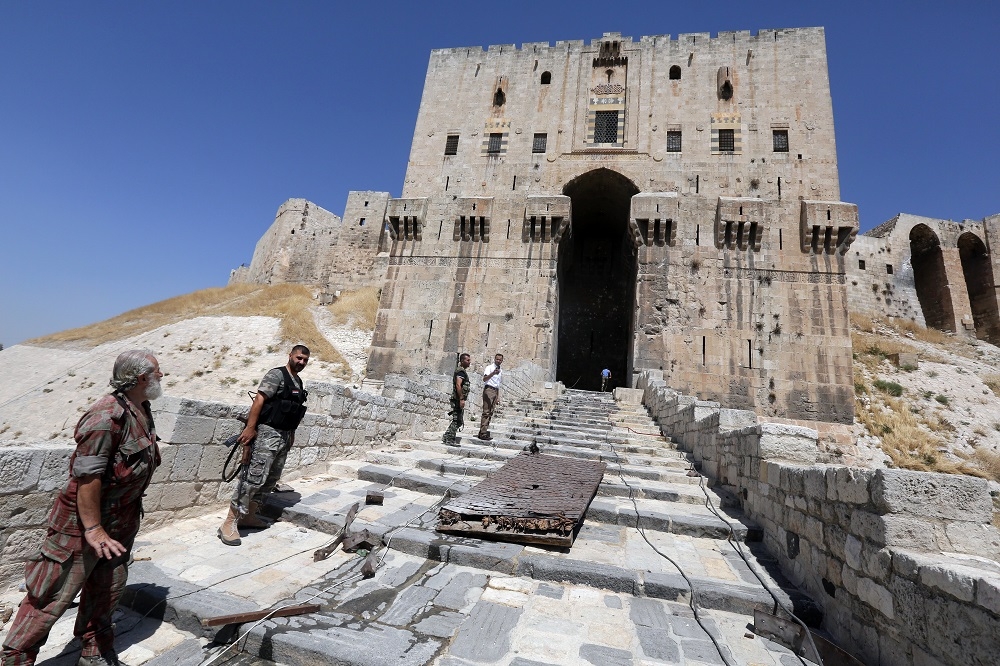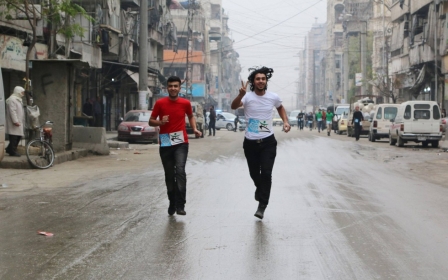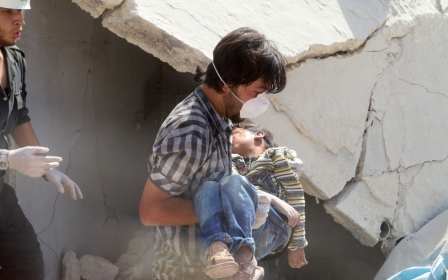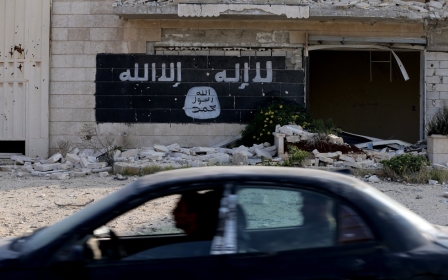
The battle for Aleppo and the rise of the jihadists
The battle for Aleppo is nearing its final critical stages, after over two years of deadly stalemate that saw the city split down the middle, and a once hopeful rebel movement disintegrate into chaos spawning radicalism and extremism in its wake. On 20 July, 2012, rebels attempted to storm Damascus after a sophisticated intelligence operation mounted by an unidentified foreign agency assassinated four top regime officials at the Crisis Management Cell on 18 July. Their backers hoped this would be a decisive and deadly blow to the regime. Their assault was ultimately unsuccessful, but a similar push would also be made by the rebels of Aleppo, with mixed results.
During the spring and summer of 2012 in rural Aleppo, the main rebel brigade - which along with an assortment of foreign and local jihadist fighters from al-Qaeda’s Syrian affiliate, Jabhat al-Nusra, would constitute the spearhead of the rebel campaign to take Aleppo - was slowly and covertly being put together by Turkey. The formation of a several thousand-strong major rebel alliance called Liwa’ al-Tawheed was officially announced on 18 July, 2012. This brigade united a plethora of disorganised and small local rebel groups which made up the core of the nascent armed insurrection in north eastern rural Aleppo. With the explicit go-ahead, logistical and military support of Turkey and the tacit approval of its NATO allies, Liwa’ al-Tawheed launched what it called the Forqan Battle on 19 July to liberate Aleppo city from the regime’s forces and claim it in the name of the revolution. The hoped-for outcome was to initiate a domino-like collapse of regime control over north Syria right down to Homs. In essence, this was “Plan B", designed to complement the assault on Damascus and seal the regime’s fate once and for all. But “Plan B” also failed, and instead of removing the regime, it brought large scale death, destruction and suffering to millions. Out of the ensuing chaos, a new scourge of deadly terrorist groups would fester and be unleashed on the world.
The battle began when sleeper cells took over the neighbourhood of Salah al-Deen on 19 July, followed by a lightning push into the eastern and north eastern areas of Aleppo city over the following two days. The battle for Aleppo, though, was not formally announced by al-Tawheed until 21 July, and later by the Military Council of the Free Syrian Army (FSA) through its leader, Abdel Jabar al-Akidi, who called for a mass mobilisation. The FSA is not thought to be involved in the initial planning or the assault itself, but wanted to appear as if though it had been. To that effect al-Akidi made full use of a photo-op, showing him strolling through Bab al-Hadeed in the old city.
It is very important to remember that at this stage, the strong presence of foreign jihadi fighters in Aleppo as well as the Syrian offshoot of al-Qaeda in Iraq (later to split off from al-Qaeda central and become the Islamic State (IS) group) Jabhat al-Nusra was well known to the outside backers of the Syrian opposition and rebels. In fact, their entrance into Syria was facilitated - or at least not meaningfully hindered - in order to make use of their superior military prowess gained through years of brutal fighting on global jihadi battlefields in helping the Syrian rebels defeat the regime’s forces.
For a critical week after the rebel assault first began, the Syrian regime seemed to be completely paralysed and was unable to mount any effective counterattacks until significant reinforcements finally arrived. In the meantime, those few troops stationed in Aleppo took up defensive positions, garrisoning themselves inside army barracks or other government buildings and security HQs and even the iconic Aleppo citadel. During that brief window of opportunity, Aleppo city was theirs for the taking, but the rebels halted their advance in eastern and some north eastern neighbourhoods. Aside from a few initial limited incursions and skirmishes, they never made any serious attempt to challenge the regime’s vital positions and centres of power. There is a lot of speculation surrounding why the assault was suddenly halted, as well as the exact circumstances of those fateful initial days. Their official narrative at the time was that they had run out of ammunition, and simply did not have enough man power to take and hold what is a very large metropolis, let alone battle hundreds of garrisoned and well provisioned regime soldiers, who would become surrounded and fight viciously for their very lives.
But it could be argued that they had plenty of time to re-arm and reorganise for the final killing blow, especially since thousands of rebel fighters from various rural groups as well as seasoned jihadists had flooded the city after its successful storming. Furthermore, they had already captured the Bab al-Hawa border crossing with Turkey (on 19 July), meaning that weapons and supplies could freely flow if their providers so wished.
So were they prevented from doing so by an order from outside? Was Plan B stopped as Turkey realised the Damascus offensive had failed, and the fall of Aleppo would bring anarchy to its long border areas (which it eventually did)? This seems to be the only logical conclusion.
Equally, was the regime purposefully luring them in to take Aleppo and calling Turkey’s bluff, knowing full well the negative repercussions the fall of Syria’s second largest and most important centre of commerce and manufacturing into chaos would have on the armed uprising and Turkey itself? Was it allowing conflict to reach Aleppo because it feared it would erupt into full-scale civil disobedience and mass protests like Hama did before it, given the unprecedented student anti-regime demonstrations at Aleppo University? Was Aleppo to be sacrificed as a showcase of the rebellion’s disastrous folly to internal and external public opinion? Was the city being set up to become a microcosm of the entire Syrian conflict highlighting the military and political stalemates and balances of power both on and off the battlefield in a cynical tragic theatre where the victims were real flesh and blood Syrian people?
In hindsight, these conclusions would appear to be very credible and not so farfetched, and a cursory look at events shortly before the rebel assault would seem to back them up. Significantly, it seems the regime had at least some advance warning of an impending invasion, as it had placed 85 checkpoints at strategic locations across the city. Mysteriously, those were removed just days before the assault which itself was met with at best token resistance, mostly by police officers surrounded inside their stations in neighbourhoods that were overran by rebels. Some claim that it was due to the complicity of Colonel Muhammad al-Mifleh, then head of the powerful Military Intelligence Branch in Aleppo responsible for the murder of protesters in the city and also infamous for his role in the massacre of over 100 protestors in a single day on the streets of Hama while he was stationed there previously. Indeed, he vanished soon after the fighting in Aleppo began and his whereabouts are still unknown. Was he just following orders as the plot to assault Damascus was uncovered and already known to the regime on 13 July? Or had he become a bought-off turn coat after becoming convinced that the regime was about to collapse? And if so, why was the regime’s central command not aware of his actions? Answering those critical questions is key to understanding what took place in Aleppo and why. But that is for future historians to work out.
The aftermath and the meteoric rise of the jihadists
In any case, there is no denying the profound significance of the battle for Aleppo and the impact it had on the rest of the Syrian uprising. Aside from furiously enflaming the civil conflict it heralded the beginning of a new phase marked by increasing violence, anarchy and radicalisation. As the central state’s grip began to weaken, it unleashed a large wave of death and destruction as it fought back to hang onto power. It also set the stage for the dramatic rise and increasing dominance of the jihadist groups on the Syrian and Iraqi scenes.
The radical seasoned jihadists of al-Nusra were at the forefront of the battle for Aleppo; indeed they were instrumental in overrunning the heavily armed regime checkpoint at Anadan, which guarded the northern approach to the city from the Gaziantep highway. Back then, they were bolstered by foreign fighters, the majority of whom later formed their own groups or joined ISIS after al-Nusra’s leader, al-Golani refused to recognise his former boss. al-Baghdadi’s authority and split. Those foreign jihadis were later clearly seen manning checkpoints across rebel held areas inside Aleppo, and freely flying the black and white Islamist and al-Qaeda banners. Their presence and contribution to the fight was extoled and defended by both the Syrian opposition in exile as well as the rebel leadership, who called them “freedom fighters coming to help their Syrian brothers against tyranny”.
Al-Nusra had the fiercest and most fearless fighters who defended crucial front-line positions, and pushed to take vital strategic areas like the Izaa’a hill, one of the highest points in Aleppo where the main broadcast towers are placed. After the initial push, their presence became increasingly more important, as other moderate rebel groups took the backseat, preferring to hang back from front lines, and increasingly engage in what was to become one of the defining hallmarks of their presence in east Aleppo, much to the dismay of its confused and shell-shocked residents: the rampant looting, crime and human rights abuses.
The steering wheel was being slowly handed over to the extremists, and the rebellion in Aleppo was beginning to veer dangerously off course with disastrous implications for Syria and the entire region. To make matters worse, the linchpin of the moderate rebels and the dominant power among them, Liwa’ al-Tawheed, was headed by a very charismatic but militarily amateurish and tactically incompetent leader. He was the infamous “Haji Marea”, the nom de guerre of AbdelKader Saleh, a former grain merchant from the town of Marea in north east Aleppo province, with strong ties to the Muslim Brotherhood. He made a series of disastrous strategic mistakes, starting with his failure to integrate Liwa’ al-Tawheed from a collection of groups with tribal and territorial affiliations into a properly structured rebel army, instead reinforcing those divisive and disruptive allegiances by assigning “afwaj” or battalions based upon them. This further exacerbated the endemic and serious problems which were emerging among the ranks of the moderate Aleppo rebel movement. The fractiousness, disunity and lack of discipline among the competing rebel groups resulted in constant infighting and reduced effectiveness in battle. From this turmoil, a new class of opportunistic and criminal warlords began to emerge, which al-Tawheed was either unwilling or unable to stop. Warlords like Hasan Jazara (later executed by ISIS) who demolished the minaret of the Grand Omayyad Mosque, and Mohamad Afash of Ahrar Souria and Khaled Hayani of Shuhada’ Bader, who orchestrated mass organised looting of residential and industrial areas, as well as serious war crimes still ongoing today through the indiscriminate shelling of civilian neighbourhoods with high explosive canisters, rockets and mortars leading to the death and injury of hundreds.
The reduced effectiveness of al-Tawheed and other rebel groups sparked fears of a possible regime counteroffensive which might successfully break rebel lines and recapture rebel held areas of the city. This prompted Haji Marea’ to make another fatal strategic mistake and reach out for help to the Salafist Militant group, Ahrar al-Sham, and accept their terms and conditions for joining the fight in Aleppo, which were basically the “Islamisation” of the revolution. This meant changing the stated objectives of the armed struggle against the regime from establishing a pluralistic democracy into creating an Islamic theocracy ruled by Sharia law. This change could be clearly detected after Liwa’ al-Tawheed dropped the green colour of the wing and the red stars from its insignia, which symbolised the revolutionary flag adopted by protesters throughout the uprising. But far more important and controversial, they also acquiesced their participation and support of the Sharia Courts (Haya’a Shariya) which were set up by al-Nusra and other jihadists to provide resolution to both civil and military disputes in the territory under rebel control on the basis of strict Sharia law overseen by clerics. This was in direct competition with a rebel court (al-Qada’ al-Muwahad) set up on the basis of common Arabian law which adopted more moderate elements of Islamic law. The jihadists saw this as a serious threat and direct challenge to their authority, and the Istakim kama omirt battalion attacked, ransacked and effectively destroyed it in November 2013, without anyone lifting a finger to intervene. The court soon dissolved itself in protest.
It is likely this was done out of necessity and not true conviction, as Liwa’ al-Tawheed, along with the rebel FSA umbrella organisation also supported the civil secular initiatives like the city council (Majles Mahali), which was set up to provide public services and administration in rebel held areas of Aleppo city. Either way, support of the jhadists gave them increasing influence and a strong say in many matters both civil and military. This campaign of “radicalisation” was furthered by the unchallenged emergence of foreign jihadi preachers, who at gunpoint would take to mosque pulpits during communal prayers and give sermons espousing the virtues of holy war and the establishment of Islamic rule.
Aside from radicalising the public and rebel fighters, another major extremist policy that went unchallenged would prove to be pivotal in greatly weakening the moderate rebel cause, that of “take no prisoners”. To be precise, it is to take prisoners but execute them openly and publicise that through video footage. Haji Marea’ in fact, tried to pin those prisoner executions on regime agents whom he said were trying to soil the reputation of Liwa al-Tawheed and the rebels and sway public opinion against them. But it was clear that both Islamists, as well as moderate rebel groups were now engaging in prisoner executions which were serious violations of international law. Those ill thought-out policies of war crimes would come back to haunt them and have disastrous consequences on the rebel movement as a whole.
In essence, what this type of execution propaganda did was reinforce the perception of their own strength and imminent victory among viewers on social and mainstream media. For the jihadi groups, it also raised their profile and credibility on the global “jihad scene”, resulting in vital flows of impressionable recruits and funding from backers sympathetic to their ideological cause. This propaganda strategy has been successfully emulated and greatly enhanced to devastating effect by the ISIS, which continues to disseminate gruesome but professionally produced and orchestrated videos of its atrocities against captured “infidels” and westerners.
But the drawback to all this was that it also stopped the slow but steady trickle of defections and desertions which had haemorrhaged the regime and threatened to seriously weaken its military capabilities. Besieged Syrian troops, many of whom were unwitting conscripts, had no choice but to fight to the death, as capture would mean certain torture and a grizzly end.
Effectively, the jihadists had strengthened their own presence and that of the regime, creating a symbiotic relationship and a mutual deadly balance, to the ultimate detriment of the moderate rebels and their revolutionary cause. The rest as they say is history, Haji Marea was killed in a regime airstrike in November 2013 that targeted a secret meeting of top Aleppo rebel leaders, as well as Allouch of Damascus and Abboud of Idleb who escaped with minor injuries. Questions still remain about who gave the coordinates and why. This greatly weakened the Aleppo rebels, who tried to unite under a new large and ambitious pan-Syrian formation called the Islamic Front, signalling their final departure from a secular identity and into a religious one.
Al-Nusra had by then been seriously weakened after it split in May 2013 from its mother ship, al-Qaeda in Iraq, as many of its members, especially the veteran foreign fighters left to join the newly created terror colossus, ISIS. Along with the Islamic Front, al-Nusra was successfully able to oust the newly created ISIS from most of Aleppo in January 2014. But by then, ISIS had already become an unstoppable colossus which dominated former rebel allies and took over their strongholds across east Aleppo from Minbeg, al-Bab and onto the provincial capital of al-Raqqa. It also captured much of the oil rich eastern province of Dier Ezzor. Those achievements in Syria gave it the momentum to spectacularly and dramatically overrun huge swathes in Western Iraq this summer in its ambitious campaign to create a functioning, self-sustaining proto-state in the mould of a hard-line Islamic Caliphate which it named simply the Islamic State. This prompted panicked alarm among those world powers that had been ignoring, or indeed facilitating its meteoric and destructive rise in Syria and treating it with indifference and apathy, even though there were clear warning signs. A hasty military coalition led by the US was formed and tasked with degrading the Islamic State’s military capability and halting its growth until a comprehensive strategy for its final defeat could be formulated.
Meanwhile, the final remnants of a defeated rebellion in north Syria were rapidly disintegrating, with some fleeing the battlefield entirely, while others joined the extremists or pledged their allegiance to ISIS as it captured their territory and assimilated their groups. Al-Nusra is now doing much the same thing to the rebels of Idleb and very soon Aleppo, out of fear that they will soon turn on it in tandem with the US led coalition’s airstrikes targeting its positions. This brings us squarely to where we are today in the messy and complex Syrian conflict. The horrific menace of the Islamic State was birthed from the chaos of Aleppo’s battle lines, which were directly fed and orchestrated by Turkey, Saudi Arabia and Qatar with the complicity of their Western NATO allies.
- Edward Dark is MEE's Aleppo-based columnist and writes under a pseudonym
The views expressed in this article belong to the author and do not necessarily reflect the editorial policy of Middle East Eye.
Photo: The citadel in Aleppo (AFP)
The views expressed in this article belong to the author and do not necessarily reflect the editorial policy of Middle East Eye.
Photo: German cellist Thomas Beckmann plays to protest against the Pegida movement demonstrating in Duesseldorf, Germany, on 12 January (AFP)
- See more at: http://www.middleeasteye.net/essays/european-fear-islam-paris-dresden-2134651465#sthash.njrjhayx.dpufThe views expressed in this article belong to the author and do not necessarily reflect the editorial policy of Middle East Eye.
Photo: German cellist Thomas Beckmann plays to protest against the Pegida movement demonstrating in Duesseldorf, Germany, on 12 January (AFP)
- See more at: http://www.middleeasteye.net/essays/european-fear-islam-paris-dresden-2134651465#sthash.njrjhayx.dpufThe views expressed in this article belong to the author and do not necessarily reflect the editorial policy of Middle East Eye.
Photo: German cellist Thomas Beckmann plays to protest against the Pegida movement demonstrating in Duesseldorf, Germany, on 12 January (AFP)
- See more at: http://www.middleeasteye.net/essays/european-fear-islam-paris-dresden-2134651465#sthash.njrjhayx.dpufThe views expressed in this article belong to the author and do not necessarily reflect the editorial policy of Middle East Eye.
Photo: German cellist Thomas Beckmann plays to protest against the Pegida movement demonstrating in Duesseldorf, Germany, on 12 January (AFP)
- See more at: http://www.middleeasteye.net/essays/european-fear-islam-paris-dresden-2134651465#sthash.njrjhayx.dpufNew MEE newsletter: Jerusalem Dispatch
Sign up to get the latest insights and analysis on Israel-Palestine, alongside Turkey Unpacked and other MEE newsletters
Middle East Eye delivers independent and unrivalled coverage and analysis of the Middle East, North Africa and beyond. To learn more about republishing this content and the associated fees, please fill out this form. More about MEE can be found here.




